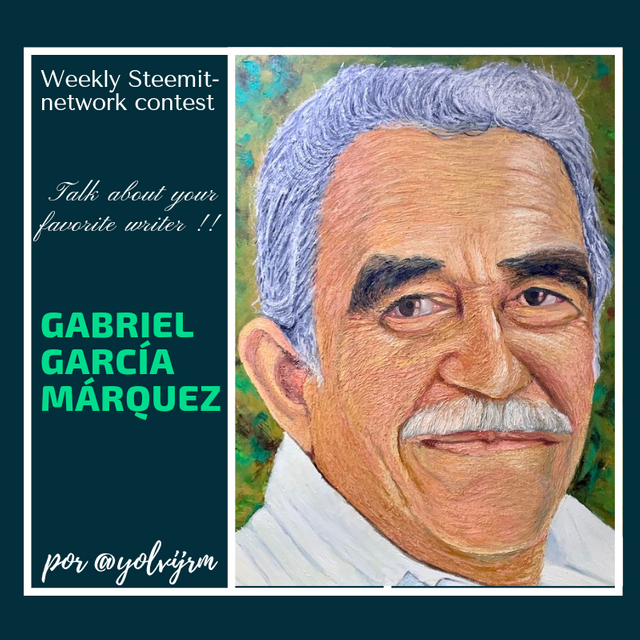Weekly Steemit-network contest || talk about your favorite writer || by @yolvijrm
Greetings to all my Stemians friends and those who live in this great community. Excited to be able to participate in this contest, which invites us to speak in relation to our favorite writer. This time I will tell you about Gabriel García Márquez.

Gabriel García Márquez was born in the Magdalena Department, Colombia, on March 6, 1927. He grew up with his maternal grandparents, as his parents went to live in the town of Sucre. Gabriel García Márquez was the fundamental figure of the so-called Boom of Hispanic American literature, an editorial phenomenon of the 1960s, which gave world projection to the last batch of Latin American storytellers.
It was precisely his grandparents who marked García Márquez's literary journey. He learned to write at 5 years old; and after finishing his high school studies, he entered the Faculty of Law of the National University of Bogotá in 1947, although he did not show excessive interest in studies. García Márquez, had a close friendship with the doctor and writer Manuel Zapata Olivella, which allowed him to access journalism, and thus his contributions to the liberal newspaper El Universal.
In 1958 he married Mercedes Barcha, with whom he had two children.
When he was 26 years old, García Márquez published his first novel, “La Hojarasca”, in which he began to show the most characteristic aspects of his fictional work, full of overflowing fantasy.
It is important to indicate that García Márquez's popularity began when “Cien Años de Soledad” was published in 1967, of which more than 8000 copies were made in one week. From that moment on, success was assured, the novel was translated into more than 24 languages and won 04 international awards.

Cien Años de Soledad, is my favorite work by this author, and recreates through the family history of the Buendía, the historical course of Macondo, an imaginary village founded by the first members of the Buendía that is the transcript of their hometown and, at the same time, of your country and the continent. This work enhances a world of its own, a mythical recreation of the real world of Latin America, showing at the same time the real with fantastic elements. This is how in the story of the founding of the town, its growth, its participation in the civil wars that occur in the country, its exploitation by an American banana company, the revolutions and the final destruction of the country. village, premonitory dreams, supernatural apparitions, insomnia plagues, biblical floods and all kinds of magical events are intertwined with all naturalness, all narrated in a very rich, fluid and captivating prose that make reading an astonishment and a difficult pleasure to finish.
García Márquez moved to Barcelona in 1969, where he established friendship with Spanish and South American intellectuals, such as Mario Vargas Llosa. His stay there was crucial to achieving what became known as the Boom of Spanish-American literature, which brought with it the international recognition of storytellers from the continent.
In 1972, García Márquez won the Rómulo Gallegos International Novel Prize, and a few years later he returned to Latin America.
Prior to Cien Años de Soledad, García Márquez had outlined Macondo's world in novels such as "La Hojarasca" (1955) and "El Coronel no tiene quien le Escriba" (1961), and also in collections of stories such as "Los Funerales de Mamá Grande" ( 1962). After Cien Años de Soledad, his narrative, stripped to a greater or lesser extent of fantastic elements, maintained a very high level; This is the case of novels such as "El Otoño del Patriarca" (1975), "Crónicas de una Muerte Anunciada" (1981); and "Love in the Times of Cholera" (1985).
His literary recognition, in 1982 awarded him the Nobel Prize for Literature, which gave him the authority to make his voice heard on Colombian political and social life.
His intervention in the cinema was related to the writing of numerous scripts, which were sometimes adaptations of his own works. His production includes a historical novel about Simón Bolívar, "El General en el Laberinto" (1989); the collection of stories "Doce Cuentos Peregrinos" (1992); the volume of memoirs "Vivir para Contarla" (2002), which covers the first thirty years of his life, and his last novel, "Memorias de mis Putas Tristes" (2004), about the love of a nonagenarian journalist for a young prostitute .
The writer died in Mexico City in 2014, after suffering from lymphatic cancer.
I hope you liked the fascinating biography of this Colombian writer and I invite you to discover his great works.
Greetings and blessings.

Hi, @yolvijrm,
Thank you for your contribution to the Steem ecosystem.
The @ecosynthesizer Curation Team,
Please consider voting for our witness, setting us as a proxy,
or delegate to @ecosynthesizer to earn 100% of the curation rewards!
3000SP | 4000SP | 5000SP | 10000SP | 100000SP